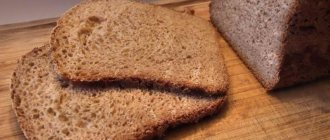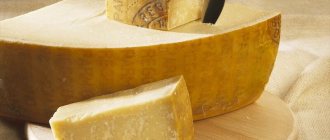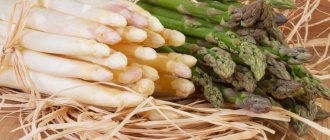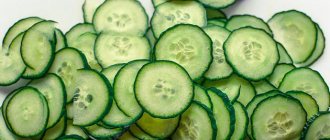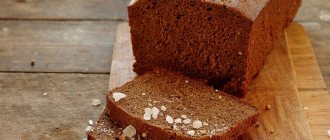Biological description
White cabbage is a member of the cruciferous family. Its shape is round, the stem is tall, the leaves are dense, wrapped inward. This garden crop is grown in different parts of the world. It is eaten in any form: fresh, pickled, stewed, fried, boiled. A good harvest of cabbage is obtained in countries with a moderately cool climate.
The most common varieties of white cabbage are early, middle and late.
Content:
- Biological description
- Origin story
- Chemical composition and nutritional value
- Beneficial features
- Harm and contraindications
- White cabbage in folk medicine
- White cabbage in cooking
- White cabbage in cosmetic procedures
- Rules for selection and storage
Early cabbage varieties include Pharaoh, Golden Hectare, Aladdin, Nakhodka and Yaroslavna. Popular varieties of medium cabbage include Podarok, Slava, Belorusskaya and Megaton. Late cabbage varieties include Snow White, Sugarloaf, Valentina, and Extra.
It is noteworthy that early varieties of the crop are poorly stored due to their delicate leaves. Therefore, early-varietal cabbage is not prepared into preparations, but is immediately consumed as food. Medium-grade cabbage is used to prepare dishes for short-term storage. Late varieties of cabbage are used to make preparations for long-term storage. Fresh fruits can be stored until the end of winter, retaining all their beneficial properties.
Good Dutch varieties occupy a special place. They are perfect for the local climate, high-yielding, juicy and delicious in taste. Popular varieties include Bronco, Musketeer, Ronco, Bingo and Python.
The benefits of cabbage for weight loss
Beneficial properties of cabbage Cabbage is extremely useful for losing weight. The presence of a large amount of dietary fiber allows cabbage to be classified as a filling product - fiber quickly and for a long time fills the stomach, giving a feeling of fullness for several hours. For weight loss purposes, fresh and boiled white cabbage is most useful. Including cabbage in your diet will help you lose weight and improve the appearance of your hair.
Cabbage as part of the diet
Cabbage is an integral product in therapeutic diets for people with stomach diseases (gastritis, gastroduodenitis and others). Cabbage is included in these diets due to its properties to reduce inflammation of the stomach and mucous membranes. In the Dukan diet, cabbage is recommended for consumption on mixed days, as cabbage contains a lot of fiber, which helps the gastrointestinal tract digest large amounts of protein. There is a cabbage mono diet, which is based on cabbage vegetable soup. Cabbage as a main dietary product helps stabilize blood sugar levels and reduce hunger.
Cabbage diet, what's what
Origin story
White cabbage can be considered one of the oldest types of garden crops. According to research by paleobotanists, it was grown on the Mediterranean coast about 4,500 years ago. On the territory of Ancient Iberia, wild cabbage was first grown. This culture then spread to Ancient Greece, Ancient Rome and Ancient Egypt. Later, residents of Transcaucasia and the Balkans appreciated its benefits and taste. Presumably, sauerkraut began to be fermented in the 9th century. Since then, travelers for a long time took sauerkraut with them on the road, along with honey and salted mushrooms. It is noteworthy that the ancient reference book of Kievan Rus “Izbornik Svyatoslav” of 1076 described the correct storage of cabbage as a food product.
From dessert to main course
White cabbage has come such a long way. Its calorie content is low, but at the same time it is rich in fiber and vitamins. For these qualities, the ancient Romans and Egyptians loved her very much. It is known that their knowledge of medicine was quite serious for that time. And what’s most interesting is that they actually served cabbage at the end of the meal, for dessert. I wish we could revive this tradition now. After all, the calorie content of white cabbage compares favorably with sweets and various desserts. By the way, in those days it was recommended to give cabbage to children from infancy so that they would grow up healthy.
Chemical composition and nutritional value
White cabbage contains a whole complex of nutrients and vitamins. The calorie content of white cabbage is 27 kcal per 100 grams of fresh product. The nutritional value of the product includes a high content of proteins, fats, carbohydrates, dietary fiber, organic acids, vitamins and micro- and macroelements. The vegetable contains glucose and fructose, which are considered easily digestible carbohydrates. They help saturate the body with energy. Pectin substances in the gastrointestinal tract are processed into a kind of gel that envelops the walls of the stomach, which prevents toxins from entering the circulatory and lymphatic systems. The product contains a full complex of vitamins B, , , , , and.
The vitamin U content in the vegetable helps restore the gastrointestinal mucosa after damage from peptic ulcers. This valuable vitamin was discovered in the 40s of the last century, when the composition of cabbage juice was studied. Interestingly, the name of the vitamin comes from the word ulcus, which translates as “ulcer.” Vitamin U also takes part in the synthesis of vitamin B4. White cabbage holds the record for the content of vitamin U, which is not synthesized in the body. When exposed to high temperatures, this vitamin is destroyed.
Cabbage menu for losing weight
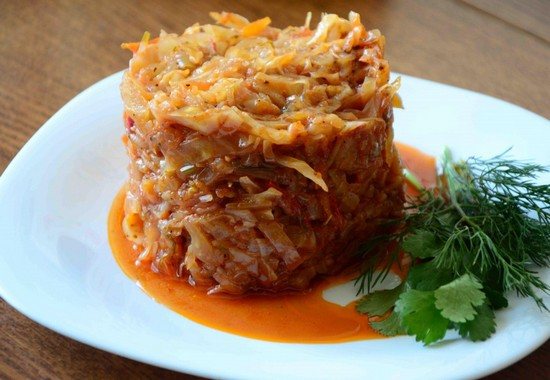
Due to the presence of a large amount of fiber and low calorie content, cabbage occupies one of the first places in the diet. But not everyone likes the taste of fresh, and even more so, boiled cabbage, so other ingredients are added to it. This improves the taste of the vegetable, but dramatically changes the nutritional value.
How many calories are in cabbage in salads and other popular dishes? The calorie will be like this:
- cabbage stewed with apples and prunes – 56 kcal;
- cabbage cutlets – 108 kcal;
- cabbage soup with sauerkraut – 50 kcal; with fresh - 46 kcal;
- onion-cabbage pie – 173 kcal;
- salad of cabbage, carrots, sunflower oil, vinegar and sugar – 100 kcal.
Those who are losing weight will benefit most from a salad that includes fresh cabbage, seasoned with low-fat sour cream, since the calorie content of this dish is only 47 kcal.
Thus, it is worth considering that depending on the chosen recipe, the calorie content of the white vegetable will change dramatically, and it can move from the dietary category to the nutritious category.
Beneficial features
White cabbage has many beneficial properties. This unique product is able to support immunity for a long time. The content of ascorbic acid in the vegetable protects against malignant tumors in the body. Ascorbic acid retains its properties during heat treatment. A lot of it is also preserved in fermented form. Folic acid, contained in green cabbage leaves, regulates metabolic processes in the body, improves the functioning of the thyroid gland and genital organs. Folic acid is especially useful and important in the diet of women.
Tartronic acid has a beneficial effect on the gastrointestinal tract, improving metabolism. In addition to choline, it does not allow cholesterol to accumulate on the walls of blood vessels and leads to the normalization of fat processes in the body. Therefore, nutritionists advise including vegetables in the daily diet for those who want to lose noticeable weight. Tartronic acid is present only in fresh cabbage. Fructose energizes the body, the amount of which in cabbage is higher than in other vegetables. Lactic acid, which is formed as a result of fermentation of the product, has a beneficial effect on the intestinal microflora. As a result of exposure to lactic acid, the intestinal microflora is normalized in the body and putrefactive processes in it are eliminated. The phytoncides contained in the vegetable have a detrimental effect on Staphylococcus aureus.
The fiber content in the vegetable helps improve motor activity in the intestines and develop beneficial microflora in it.

Constant consumption of white cabbage benefits the body:
- strengthens the immune system;
- stabilizes acid-base balance;
- prevents the development of atherosclerosis;
- improves metabolic processes;
- removes toxins from the body;
- moisturizes the skin;
- removes excess fluid from the body.
Sauerkraut retains its beneficial properties and perfectly helps with dysbacteriosis and cleanses harmful microorganisms.
Stewed, sauerkraut and fried cabbage - the difference in calories
During heat treatment, the energy value of the vegetable remains virtually unchanged or decreases slightly.
If you add other products, the final numbers are obtained by summing the calorie content of all ingredients. The value decreases due to processing of the product in boiling water, increasing the volume of fibers. At the same time, the number of useful substances decreases. Stewed vegetables with the addition of mushrooms, tomatoes, butter or sausage are more nutritious. In this case, the indicator can increase by another 80 units (without additives, value = 36 kcal).
Pickled vegetables (18 kcal), pickled vegetables (19 kcal) are also suitable for dietary nutrition. Moreover, the latter option has a negative calorie content. The value of fried and baked cabbage directly depends on the type and amount of oil. When using regular sunflower oil, the indicator is ~50 kcal when roasting, 98 kcal when baking.
Harm and contraindications
White cabbage brings great benefits to the body, however, despite this, it has some contraindications. First of all, it is contraindicated to consume a lot of cabbage for people who have increased acidity of gastric juice, as well as for those who are prone to indigestion, colitis and enteritis. Excessive consumption of this raw vegetable may result in bloating, nausea, gas, and heaviness in the stomach. The vegetable is contraindicated in patients with the acute stage of myocardial infarction.
Pregnant women should consume small amounts of fresh vegetable due to the fact that it stimulates flatulence. Conversely, it is recommended to consume sauerkraut daily in winter (about 200 grams).
Young mothers often have a question about whether white cabbage can be given to a small child. It is very useful to give cabbage to children, but it must be introduced into the menu gradually, starting from 2 years. Young children are not recommended to eat a lot of sauerkraut or salted cabbage, so as not to disrupt kidney function. When feeding infants, the effects of overeating can be transmitted through mother's milk.
White cabbage can be harmful if its stalk is consumed raw. Nitrates accumulate in the stalk, which are absorbed by the vegetable during ripening. Therefore, nitrates, sodium salts and cadmium can enter the body. Nitrates are usually hidden in the stalk and upper leaves of the vegetable.
White cabbage in folk medicine

In folk medicine, cabbage leaves are widely used to treat various diseases. Our ancestors often applied them to wounds, inflamed areas and bruises, and protruding veins. Night compresses help with this, they relieve swelling and pain symptoms.
Cabbage juice is an effective remedy. It heals duodenal ulcers, cleanses the body and helps reduce weight. A side effect of its use may be high gas formation. This is explained by the fact that the juice, as a result of a chemical reaction, breaks down rotting products in the intestines. Therefore, after drinking juice, there may be an increased amount of gases, as a result of a large number of accumulated toxins and rotting products. In turn, enemas will help remove gases and further cleanse the intestines.
Cabbage and carrot juices help cleanse the oral cavity of infections leading to periodontal disease. Homemade cabbage juice cures constipation, which often leads to skin rashes. Elimination of constipation leads to the disappearance of skin rashes. For the treatment of chronic gastritis with low acidity, liver and spleen diseases, it is useful to drink 0.5 glasses of warm juice an hour before meals. The juice is stored in the refrigerator for no more than 2 days.
When diluted with sugar, cabbage juice is an excellent remedy for a hoarse voice and chest cough. For treatment you need to take 1 teaspoon 2-3 times a day. If you mix the juice with honey, you get an effective remedy for combating respiratory diseases.
Sauerkraut juice is useful in the treatment of hemorrhoids. For treatment, you need to take 0.5 cups half an hour before meals. Gradually you need to increase the amount to 5 glasses per day. The duration of treatment is 3-4 weeks.
Eating cabbage gives good results in the treatment of gout. It is consumed fresh in salads and fresh leaves are additionally applied to pain points. Fresh leaves are also applied to sore spots for eczema, headaches, radiculitis and burns. It is effective to apply leaves with grated laundry soap to affected areas for osteochondrosis. For cancer of the stomach and intestines, you need to take a mixture of cabbage roots and seeds - 1 tablespoon is poured into a glass of hot boiled water and boiled for 10 minutes. After an hour, filter and drink 3 times a day. For liver diseases, drink 0.5 cups of sauerkraut brine with tomato juice. To treat rickets in children, a decoction of cabbage, carrots and beets is used.
How to choose the right cabbage
First of all, you should pay attention to the color and density of the cabbage. In mature cabbage, the color of the head can be different shades of bright green; when cut, it is white. Any dark spots indicate a spoiled or stale product. The stalk should be about 3 cm, if less, there is a possibility that the cabbage has already begun to rot and the stalk was cut off to give the product a fresher look. The head of cabbage should be dense, without splits, cracks or dents. A ripe head of cabbage weighs at least a kilogram; small heads of cabbage have not had time to ripen and contain few vitamins. Cabbage leaves should be dense and thin
Thick leaves may indicate a high nitrate content in cabbage.
For adults, it is recommended to consume at least 150 grams of cabbage 3 times a week. Including cabbage in your daily diet is not advisable, as this can lead to a lack of nutrients that are not present in cabbage.
For children, the norm for cabbage consumption is no more than 100 grams. Children can eat cabbage in small portions every day.
White cabbage in cooking
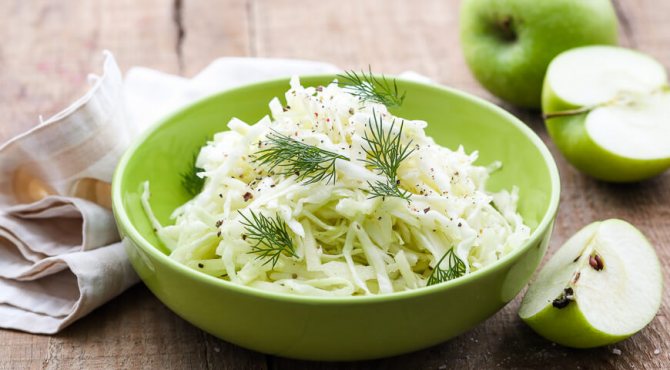
White cabbage is very popular in cooking. It is used to make delicious cutlets, soups, borscht, pies, dumplings, cabbage rolls and pancakes. It is eaten in salads, fermented, pickled, boiled, steamed, fried, baked and stewed. It is one of the best and useful preparations for the winter.
In cooking, there are several rules for properly cutting this vegetable. Leaves are removed in several ways:
- cut out the stalk and manually cut the vegetable;
- blanch;
- Place the cabbage in the microwave for 5 minutes and disassemble the leaves.
Separately, it is worth noting about the preparation of fermented product. If cabbage radically changes its taste, but is still crunchy, then it is better to eat it in a salad. If it has changed color and structure, then it is better to add it to the borscht. In this state, the acid in the vegetable goes well with the sweet beets.
Preparing pickled cabbage is very easy. For this you need 2 kilograms of cabbage, a head of garlic and 2 carrots. Dilute 1/3 cup of apple cider vinegar in a liter of water, add 2 tablespoons of salt, a glass of granulated sugar, bring to a boil and pour in chopped vegetables. Leave in a warm place for 6 hours, then put in the refrigerator.
How to cook a delicious diet dish?
From a simple and healthy vegetable you can prepare several not only low-calorie, but also delicious dishes.
No oil
Ingredients:
- cabbage – 700 g;
- water – 200 ml;
- a pinch of salt and pepper.
Place finely shredded cabbage in a pan with heated water. Simmer on low heat for 20-25 minutes.
If the recipe gets boring, you can add the juice of ¼ lemon, this will give the dish an original taste.
With butter
Ingredients:
- cabbage – 700 g;
- sunflower oil – 1 tbsp. l;
- water – 200 ml;
- a pinch of salt and pepper.
Place finely shredded cabbage in a frying pan, add oil and spices. Fry over medium heat for 7 minutes, stirring frequently. Pour in water and simmer on low heat for 20-25 minutes.
With onions and carrots
Ingredients:
- cabbage – 700 g;
- onion – 2 small onions;
- carrots – 2 pcs;
- sunflower oil – 1 tbsp;
- water – 200 ml;
- a pinch of salt and pepper.
Fry finely chopped onion over medium heat, adding 1 tablespoon of oil. Grate the carrots on a coarse grater and add to the onion. Fry until golden brown.
Mash the shredded cabbage with your hands and place in the pan. Add some spices. Reduce the stove temperature to minimum, add water and simmer for 20 minutes.
With Chiken
Ingredients:
- cabbage – 700 g;
- chicken breast – 400 g;
- sunflower oil – 1 tbsp. l;
- water – 200 ml;
- a pinch of salt and pepper.
For cooking, it is recommended to take chicken breast. Cut the breast into small pieces. Heat the frying pan to 180 degrees, do not add oil. Fry the poultry pieces with salt. To ensure even cooking and to avoid burning the food, the contents of the pan must be stirred periodically.
Mash the shredded cabbage with your hands and place in the pan. Add some spices and 1 tablespoon of sunflower oil. Reduce the stove temperature to minimum, pour in 200 ml of water and simmer for 25 minutes.
It is recommended to fry meat and poultry without using oil. To prevent the dish from burning, you need to stir the food cut into small pieces frequently and thoroughly. If necessary, you can add water.
An unplanned interruption of a diet is often due to the fact that a person who has decided to lose weight quickly gets tired of crunching on permitted vegetables every day. The statement that diet food is sad, tasteless and monotonous is a common misconception that has ruined many worthy endeavors.
We must not forget that the effectiveness of any diet increases significantly with the addition of small physical activities. Nobody canceled the 10,000 steps per day.
There is almost no food in the refrigerator or do you just want something light but tasty? Delight your family with an original cabbage dish or salad. We offer several interesting recipes, the main components of which are cabbage and eggs. All recipes are basic, they can be modified depending on the availability of products and personal wishes. Calorie content of 100 grams is approximately 68 kcal.
White cabbage in cosmetic procedures
In cosmetology, the use of cabbage is indispensable at home. Its leaves and juice are used to whiten facial skin, strengthen hair and care for hands. To prepare a face mask, you need to take 2-3 raw vegetable leaves and pour milk (10 ml) over them, cook until soft. Make the resulting mass homogeneous and apply to the face before going to bed for 15 minutes. To strengthen hair, take cabbage, spinach and lemon juices in equal parts. This mixture is rubbed into the hair roots for 7 days before bedtime. A famous French recipe for hand care includes sauerkraut juice. It is heated and applied to the hands, then washed off and a nourishing cream is applied.
For women
Appetizing crispy sauerkraut is traditionally considered a very valuable product for the health and beauty of women. This is due to the wide range of beneficial properties described above. First of all, of course, the dietary characteristics of sauerkraut matter. Its regular presence in the diet leads to many positive changes:
- the digestive system is cleansed and disinfected;
- blood cholesterol levels decrease;
- metabolic processes are normalized;
- skin and hair become young and healthy.
Cabbage leaves are useful not only for weight loss, but also for pregnant women who help cope with toxicosis. There are also known methods for their cosmetic use:
- to get rid of acne and acne, you need to tightly place chopped sauerkraut pulp on your steamed face and cover with a napkin for half an hour;
- You can make a mask from the brine against age spots and freckles - just put a napkin soaked in it on your face for 10-15 minutes, and then wash your face.

Cabbage in a tub
